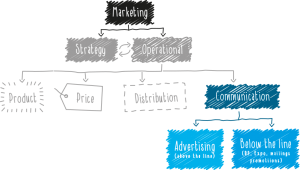In our world, the world of building brands and getting people to respect and trust companies enough that they “buy their stuff”, we hear these four terms: marketing, communication, advertising and publicity, almost all the time. What is also constant is that these terms are very often used interchangeably, just as much by those who should know the difference, as by those whose only concern is to “sell their stuff”.
It’s easy to see how the terms marketing, communication, advertising and publicity are easily confused.
From a business owner’s viewpoint all four are means of achieving growth, profit or notoriety.
In truth they are not entirely separate actions, but work together in a reciprocal back-scratching way, the borders have been further blurred in recent years with cross-purpose digital campaigns, and really, it’s getting harder to distinguish what’s what. What is clear however, is that each of them provides numerous brand touchpoints, that together will define the identity of your organisation, product or service.
So, as a lesson in ‘back-to-basics’ let’s see what each is supposed to represent and how to distinguish one from the other.
Marketing
Of the four terms ‘Marketing’ is the one which really throws a spanner in the works. You will find dozens of examples of operations that are attributed to marketing, when they would be more accurately described as “communication” or “advertising”.
Our definition of marketing is quite simple: marketing matches the company, its products and its services with the needs and expectations of a target market.
Strategic marketing is about forward-thinking and can be illustrated by:
- Defining global strategies
- Conducting studies of consumer behaviour (client persona)
- Defining the marketing objectives of each product on a market (targeting), this in turn will often lead to creating or evolving the graphic identity.
We also talk about ‘Operational marketing’. These are marketing techniques and actions in order to meet the objectives of your marketing strategy. This branch can itself be divided into the famous “marketing mix” sub-branches, better known as the 4P’s :
- Product
- Price
- Promotion (communication)
- Place
These are often extended for services by a further 3 P’s: People, Physical evidence and Process.
See article: Marketing mix and brand identity working together for Services.
Communication
To communicate is to pass a message directly from a transmitter to a receiver via a communication channel (At our agency we refer to this as the blue bridge). Communication also means defining the tools and media to convey the communication strategy.
For example communication actions could be:
- Creating a communication plan
- The development of an Internet site
- Distributing flyers
- Signs on buildings and vehicles
Advertising
To advertise is to broadcast a promotional message using purchased media space (TV, radio, cinema, press, web…).
For example:
- Designing and broadcasting an advertisement on television
- A public transport poster campaign
- Google Adwords campaign
In its classic definition, advertising is a ‘non-personalised’ action, in that does not require interaction with the future client. This vision is now blurred with digital advertising that allows targeting, customization and advanced interaction. See article ‘Inbound and Outbound marketing’.
Publicity
This is often confused with Advertising, as publicity is one of the expected results of advertising.
The term publicity is a combination of two words ‘public’ and ‘visibility’. It refers to the flow of information (fact or fake), regarding general awareness about a subject. Here the subject may include a person, product, service, business entity and so on. It is used to draw the public’s attention, with the help of broadcast media, print media or social media. Publicity can be helped by Public Relations actions.
The most telling difference between Advertising and Publicity is that advertising is what a company says about its own product, but publicity – like branding – is how others feel about a product, service or organisation.
Difference between marketing and communication, advertising and publicity
So you get the picture: to advertise or communicate is part of your marketing mix, and publicity can be a result of any or all of the three others.
Marketing can be divided into 2 main branches: Strategic marketing and operational marketing.
And finally, communication can itself be divided into 2 sub-branches:
- Media (advertising)
- Non-media (exhibitions, merchandising, sponsoring, blogs, press relations, direct marketing…)
And – now you’ve memorised the above – don’t forget: all of them contribute to your brand identity.
If you would like to discuss how marketing, advertising, publicity and communication can influence your brand identity then let’s talk. Contact us.

Branding Consultant at Pont Bleu Communication
Daren Birchall’s career spans more than 30 years. He is a graphic designer, writer, analyst and communications strategist, marketing consultant, media buyer, production manager, and for quite some time was an advertising agent. He loves photography but his glasses bother him.




